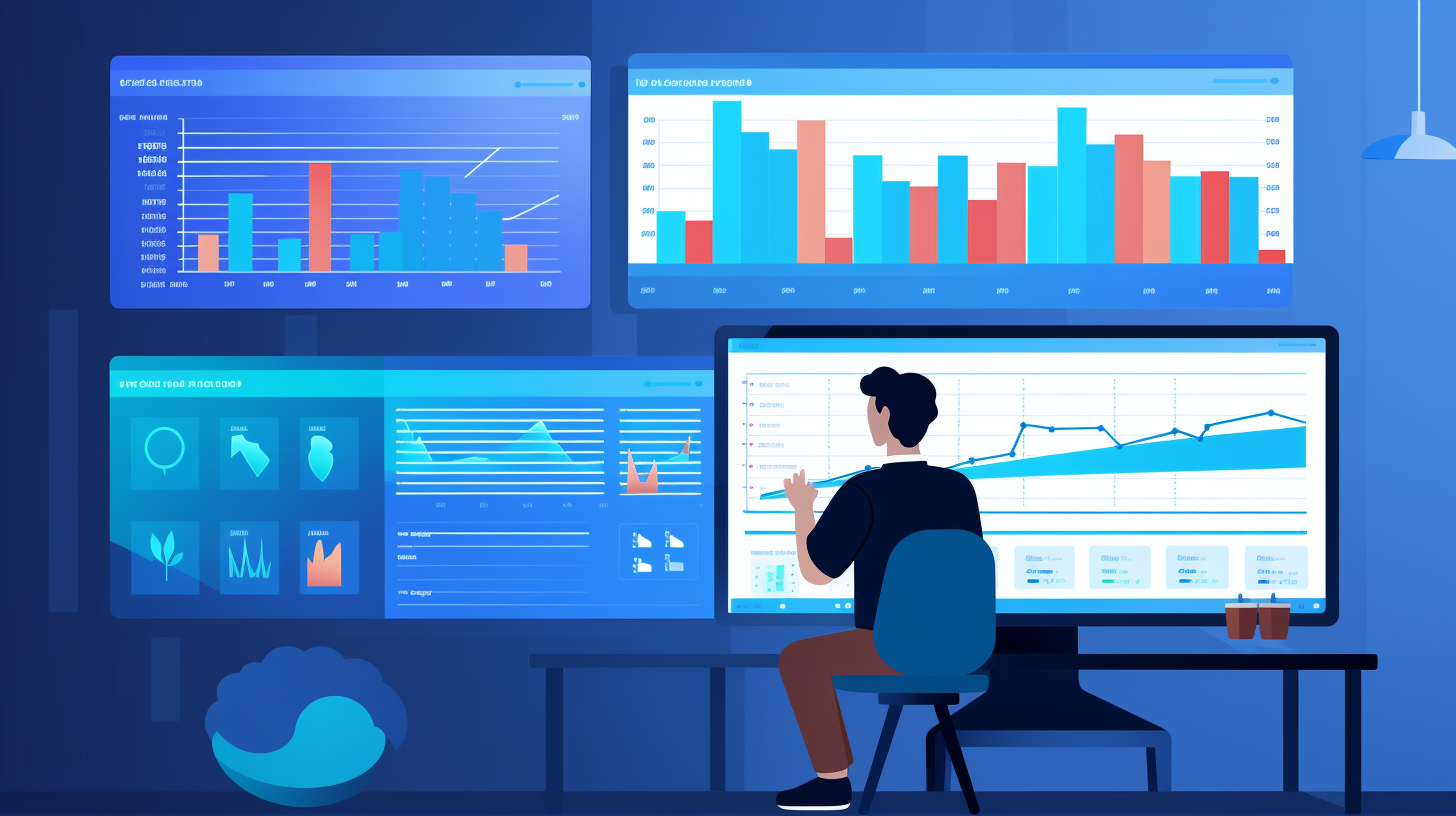受众分析是任何成功的网站策略的关键组成部分。它涉及了解和洞察目标受众的特征、偏好和行为。通过有效地分析受众,您可以定制内容、营销策略和网站体验,以满足他们的需求和期望。
在 WordPress 的世界里,受众分析变得更加重要。借助一系列可用的插件和工具,您可以收集有价值的数据并更深入地了解您的网站访问者。这些知识可以帮助您做出明智的决策,以增强用户参与度、改善搜索引擎优化 (SEO),并最终为您的网站带来更多流量。
在本文中,我们将探讨在 WordPress 中成功进行受众分析的高级技术。我们将讨论各种方法、插件和工具,它们可以帮助您收集人口统计详细信息、分析社交媒体存在、优化网站体验、细分受众等等。通过应用这些技术,您将能够改进您的策略,有效地接触和吸引目标受众,并实现您的网站目标。
那么,让我们深入研究如何释放 WordPress 中受众分析的力量!
利用受众分析插件
您是否想知道谁访问了您的网站以及他们访问后会做什么?了解您的受众对于打造有效的在线形象和定制内容以满足他们的需求至关重要。值得庆幸的是,有几种受众分析插件可以提供有关您网站访问者的人口统计、行为和兴趣的宝贵见解。在本文中,我们将探讨三种流行的插件,它们可以帮助您更深入地了解您的受众。
适用于 WordPress 的 Google Analytics(分析)
首先,我们有 适用于 WordPress 的 Google Analytics(分析)。这个强大的插件将您的 WordPress 网站与 Google Analytics 无缝集成,让您可以访问有关网站流量的详细报告。借助 Google Analytics,您可以深入了解受众行为的各个方面,例如:
- 人口统计: 了解访客的年龄、性别和位置。这些信息可以帮助您定制内容和营销策略,以有效地定位您的受众。
- 行为流程: 了解访客如何浏览您的网站,包括他们进入和退出的页面。这些数据可以帮助您优化网站结构并改善用户体验。
- 转化追踪: 跟踪您的营销活动的有效性并衡量您的目标(例如新闻通讯注册或在线购买)的成功程度。
Google Analytics 提供了丰富的信息,可以帮助您做出数据驱动的决策,以改进您的网站并更好地服务您的受众。
联系表格数据库
我们名单上的下一个是 联系表格数据库,这款插件的功能远不止分析网站流量那么简单。这款插件专注于收集和分析用户通过您网站上的联系表单提交的数据。
使用 Contact Form DB,您可以通过检查从联系表单提交中收集的数据来深入了解访问者趋势和模式。此插件的一些主要功能包括:
- 数据收集: 收集和存储通过联系表单提交的数据,包括姓名、电子邮件地址和询问信息。
- 搜索和过滤: 轻松搜索和筛选联系表单提交内容,让您能够识别客户查询的趋势和模式。
- 导出和分析: 导出从联系表单提交收集的数据,以便进一步分析并与其他工具集成。
通过分析联系表收集的数据,您可以更好地了解受众的兴趣、需求和关注点。
新统计报
最后,我们有 新统计报,一款全面的实时 WordPress 插件,可提供有关您网站流量来源、访客趋势等的宝贵见解。NewStatPress 的一些主要功能包括:
- 访客信息: 查看有关您的网站访问者的详细信息,包括 IP 地址、浏览器和操作系统。
- 实时统计数据: 实时监控您网站上当前的访问者数量及其活动,让您立即了解网站的性能。
- 流量来源: 确定您的网站流量来源,包括搜索引擎、社交媒体平台和推荐网站。
通过利用 NewStatPress,您可以更好地了解访问者如何发现您的网站并跟踪您的营销活动的有效性。
总之,受众分析插件(例如 WordPress 版 Google Analytics、Contact Form DB 和 NewStatPress)可以提供有关网站访问者的人口统计、行为和流量来源的宝贵见解。通过利用这些插件提供的数据,您可以做出明智的决策来改进您的网站、制作有针对性的内容并优化您的整体在线形象。那么,还等什么呢?立即开始使用这些强大的插件,释放您网站受众分析的潜力。
收集人口统计详细信息
在了解受众并定制内容以满足他们的需求时,收集人口统计详细信息至关重要。通过分析人口统计数据,您可以深入了解目标受众的特征和偏好,从而帮助您创建与他们产生共鸣的内容。在本文中,我们将探讨收集人口统计详细信息的不同方法,重点是进行访谈和焦点小组讨论。
进行访谈和焦点小组
访谈和焦点小组是收集有关受众偏好和需求的定性见解的强大工具。通过直接与个人或小组接触,您可以深入了解他们的想法、观点和经历。以下是进行访谈和焦点小组时要遵循的一些基本步骤:
- 明确你的目标:在进行访谈或焦点小组讨论之前,请明确定义您的研究目标。您希望收集哪些具体信息?您的关键研究问题是什么?
- 制定面试指南:准备一份结构化的访谈指南或讨论主题,以确保访谈期间的一致性和重点。本指南将作为您的访谈或焦点小组讨论的路线图,确保您涵盖所有相关主题。
- 招募参与者:确定符合目标受众特征的个人,并邀请他们参加访谈或焦点小组。考虑使用不同的招聘方法,例如在线平台、社交媒体或专业网络。
- 选择正确的设置:为您的访谈或焦点小组选择一个舒适且中立的地点。它可以是会议室、咖啡店,甚至是用于远程会议的虚拟环境。
- 营造包容氛围:营造开放、不带偏见的环境,让参与者可以自由地分享自己的想法和意见。鼓励积极参与,确保每个人都有平等的机会做出贡献。
- 提出开放式问题:使用开放式问题鼓励参与者自由表达自己的想法。避免使用可能影响他们回答的诱导性或偏见性问题。让他们分享与您的主题相关的经验、偏好或挑战。
- 积极倾听:积极倾听参与者的回答并提出后续问题以深入了解他们的见解。在会议期间做笔记,以确保准确捕捉重要细节。
- 分析和解释数据:访谈或焦点小组结束后,记录并分析收集的数据。寻找从回应中浮现出的模式、重复出现的主题和关键见解。这些见解将有助于制定内容策略。
请记住,访谈和焦点小组是定性研究方法,可提供丰富而深入的见解。但是,它们可能并不代表整个人群的观点。因此,必须用定量数据补充这些方法,以确保全面了解您的受众。
通过进行访谈和焦点小组讨论,您可以收集到有价值的人口统计信息,而这些信息不仅仅是统计数据。这些定性见解可以让您更深入地了解受众的想法、偏好和需求,让您能够创作出真正能引起他们共鸣的内容。因此,请毫不犹豫地直接与您的受众互动,并开始收集这些有价值的人口统计信息。
分析社交媒体影响力
在当今的数字时代,拥有强大的社交媒体影响力对于企业和个人都至关重要。社交媒体平台为与目标受众建立联系、分享内容和建立品牌知名度提供了完美的途径。然而,仅仅在这些平台上拥有影响力是不够的;分析和了解社交媒体工作的有效性也同样重要。这就是 Followerwonk 等工具发挥作用的地方。
使用 Followerwonk 等工具
要真正衡量您的社交媒体影响力,深入挖掘和分析关键指标(例如受众参与度和兴趣)至关重要。Followerwonk 就是证明其价值的地方。Followerwonk 由 Moz 开发,专为 Twitter 设计,可让您深入了解您的关注者,并将其与竞争对手进行比较。
Followerwonk 可以这样帮助你分析你的社交媒体表现:
- 比较您的关注者: Followerwonk 可让您将您的关注者与竞争对手的关注者进行比较。此信息可帮助您了解您的受众与竞争对手的受众有何不同,并确定潜在的增长机会。
- 分析参与度: Followerwonk 提供详细的参与度指标,例如转发、回复和提及。这些数据可让您衡量内容与受众的共鸣程度,并就您的社交媒体策略做出明智的决策。
- 确定影响者: Followerwonk 还可以帮助您识别行业内已经关注您的有影响力的人。这些信息对于建立关系和利用这些有影响力的人扩大您的影响力非常有用。
- 了解观众的兴趣: 通过分析关注者的个人简介和位置数据,Followerwonk 可以深入了解他们的兴趣和人口统计。这些信息有助于定制您的内容,并确保您迎合目标受众的喜好。
Followerwonk 界面直观,分析能力先进,可帮助您根据数据做出有关社交媒体表现的决策。通过了解受众人口统计、参与度和兴趣,您可以优化内容策略并增强社交媒体表现。
因此,如果您希望将社交媒体影响力提升到一个新的水平,请尝试使用 Followerwonk。它是一款功能强大的工具,可以提供有价值的见解并帮助您与目标受众建立有意义的联系。
优化网站体验
在优化您的网站体验时,您可以实施两种关键策略来确保您的访问者获得无缝且引人入胜的体验:利用 A/B 测试插件和跟踪用户活动。
利用 A/B 测试插件
A/B 测试是一个强大的工具,可让您比较网页的两个版本,以确定哪个版本效果更好。通过实施 A/B 测试插件,例如 Nelio A/B 测试 在您的网站上,您可以做出数据驱动的决策,根据受众的偏好来优化您的网站。
这些插件可让您创建网页的不同版本并相互测试。通过随机分配访客,您可以收集有价值的见解,了解哪个版本可带来更高的转化率、参与度或您设定的任何其他特定目标。
通过 A/B 测试,您可以尝试网站的各种元素,例如标题、图片、号召性用语按钮、布局,甚至网站导航。通过测试这些元素,您可以做出明智的决定,确定哪些元素最能引起受众的共鸣并提升他们的整体体验。
跟踪用户活动
了解受众的参与度和行为对于优化网站体验至关重要。通过跟踪用户活动,您可以深入了解访问者如何与您的网站互动,并确定需要改进的地方。Google Analytics 等工具可为您提供详细的指标和数据,帮助您做出数据驱动的决策。
通过用户活动跟踪,您可以收集以下有见地的信息:
- 您网站上访问量最大的页面。
- 用户在每个页面上花费的平均时间。
- 跳出率(仅浏览一个页面后离开的访问者百分比)。
- 转化率(完成所需操作(例如购买或填写联系表)的访客百分比)。
- 用户浏览您的网站的路径,包括他们在特定页面之前和之后访问的页面。
通过分析这些数据,您可以识别模式,了解用户偏好,并定制您的网站以提供更加个性化和更具吸引力的体验。
整合 A/B 测试插件并跟踪用户活动将使您能够不断优化和增强网站体验。通过了解受众的偏好和行为,您可以确保您的网站提供用户友好且引人入胜的体验,最终提高转化率和客户满意度。
细分受众
在营销领域,没有放之四海而皆准的策略。每个受众都是独一无二的,有自己独特的需求、偏好和行为。这就是为什么受众细分对于有效的营销活动至关重要。
但受众细分到底是什么? 嗯,这是根据人口统计、兴趣和行为等各种因素将目标受众划分为更小、更易于管理的群体的过程。通过细分受众,您可以定制内容和营销策略,以更好地满足每个特定群体的需求。
定制内容和营销策略
1.人口统计: 人口细分包括根据年龄、性别、位置、收入水平和职业等特征划分受众群体。了解这些人口因素可以深入了解不同群体受众的偏好和需求。例如,如果您正在营销护肤品牌,您可能会发现年轻受众对抗衰老产品更感兴趣,而年长受众可能更关心保湿和防晒。
2. 兴趣: 根据受众的兴趣进行细分,您可以创建符合他们热情和爱好的内容和营销策略。通过了解受众的热情所在,您可以根据他们的兴趣定制信息。例如,如果您正在推广一款健身应用,您可以创建专门针对瑜伽、跑步或举重爱好者的内容。
3.行为: 根据行为进行细分需要分析受众如何与您的品牌互动。这包括他们的购买模式、与您的网站或应用的互动以及对营销活动的响应。利用这些信息,您可以制定有针对性的策略来培养客户忠诚度、重新吸引休眠客户或向常客追加销售。
“通过根据人口统计、兴趣和行为细分受众,您可以制定针对性营销策略,直接满足每个群体的需求和偏好。这种个性化方法增加了吸引他们注意力、建立信任并最终推动转化的可能性。”
细分受众并非一次性任务。这是一个持续的过程,需要随着受众的变化而定期分析和调整。通过密切关注受众不断变化的需求和偏好,您可以不断完善和优化营销工作,以实现最大效果。
请记住,成功细分受众的关键之一是持续收集和分析数据。监控您的活动,跟踪客户互动,并使用工具和分析来深入了解受众的行为。掌握这些知识后,您将能够在正确的时间向正确的人传递正确的信息。
内容分析和观众偏好
作为内容创作者,了解受众的喜好并创作能引起他们共鸣的内容至关重要。这就是内容分析发挥作用的地方。通过分析目标受众中流行的话题,我们可以定制内容以满足他们的需求和兴趣。在本节中,我们将探讨内容分析如何帮助我们识别热门话题并创作引人入胜的内容。
识别热门话题
内容分析涉及检查受众最常讨论或搜索的主题。通过分析数据,我们可以深入了解当前哪些主题受欢迎且需求量大。这可以帮助我们创建相关且符合目标受众兴趣的内容。
以下是我们可以通过内容分析来识别热门话题的几种方法:
- 关键词研究:通过进行关键字研究,我们可以确定受众正在积极搜索的关键字和短语。Google 关键字规划师或 SEMrush 等工具可以提供有关特定关键字的搜索量和竞争情况的宝贵见解。通过关注搜索量高、竞争低的关键字,我们可以创建更有可能被目标受众发现的内容。
- 社交聆听:社交媒体平台提供了有关当前受众群体中流行哪些话题的宝贵数据。通过监控社交媒体对话、主题标签和趋势,我们可以识别出引起大量关注的话题。Hootsuite 或 Sprout Social 等工具可以帮助跟踪特定主题的对话和情绪。
- 分析:分析网站分析结果可以让我们深入了解哪些主题能引起受众的共鸣。通过检查页面浏览量、页面停留时间或跳出率等指标,我们可以确定哪些主题能产生最多的参与度和兴趣。Google Analytics(分析)是一款功能强大的工具,可用于跟踪这些指标并深入了解受众行为。
- 竞争对手分析:研究竞争对手的内容也能让我们深入了解热门话题。通过分析他们分享或评论最多的内容,我们可以确定推动我们行业或细分市场参与度的话题。这可以帮助我们创建吸引目标受众的类似内容。
请记住,内容分析的目的是了解哪些主题会引起观众的共鸣。通过花时间确定热门主题,我们可以创建不仅能吸引更多访客,还能让他们保持参与并再次访问的内容。
“内容分析帮助我们识别与目标受众产生共鸣的热门话题和主题,使我们能够创建更具吸引力和相关性的内容。” 在此处了解有关内容分析的更多信息.
网站流量和推荐分析
在网站管理和在线营销领域,了解受众兴趣是成功的关键。了解是什么推动了您的网站流量,其中一种方法就是分析您的网站流量和推荐来源。这种分析可以提供有关您的受众是谁以及他们感兴趣的内容的宝贵信息。通过利用这些知识,您可以优化您的网站内容和营销策略,以更好地满足您的受众的需求。让我们深入了解通过网站流量和推荐分析了解受众兴趣的重要性。
了解观众的兴趣
分析流量和引荐来源可以提供有关受众兴趣和偏好的宝贵信息。通过检查网站流量的来源,您可以确定哪些渠道为您的网站带来了最多的访问者,哪些渠道最有效地将这些访问者转化为客户。然后,您可以将精力集中在产生最佳效果的渠道上。
在查看推荐来源时,必须考虑数量和质量。您不仅应该查看来自每个来源的访客数量,还应该查看与每个来源相关的参与度和转化率。这些数据可以深入了解哪些类型的内容和营销活动能引起目标受众的共鸣。
为了说明了解受众兴趣的重要性,请考虑以下场景:
假设您有一个关于健康烹饪的博客,并且您注意到大量流量来自专门从事健身和健康的网站。此信息表明您的受众对健康相关主题非常感兴趣。掌握了这些信息后,您可以定制内容,以包含更多符合受众兴趣的食谱、烹饪技巧和营养信息。此外,您可以探索与健身和健康网站的合作机会,以进一步扩大您的覆盖范围。
通过定期分析网站流量和推荐来源,您可以领先于趋势并相应地调整策略。这种数据驱动的方法可让您做出明智的决策并创建以用户为中心的体验,让您的受众保持参与度并再次光顾。
总之,通过网站流量和推荐分析了解受众的兴趣是有效在线营销的一个重要方面。通过深入了解受众的偏好和行为,您可以优化内容和营销工作,从而提高参与度、转化率和整体成功率。因此,深入研究您的分析并发现是什么让您的受众感兴趣!
创建买家角色
了解用户需求
为了创建有效的买家角色,深入了解目标受众的需求、偏好和痛点至关重要。通过获得这种洞察力,您可以开发与受众产生共鸣并推动有意义的参与的内容和设计策略。但是您如何才能了解这些用户需求呢?让我们深入探讨一下!
1.数据分析: 首先分析现有数据以发现模式和趋势。查看网站分析、客户反馈和销售数据,深入了解用户的行为和偏好。这些数据将提供有关其人口统计、在线习惯和购买模式的宝贵信息。
2.调查和访谈: 对现有客户进行调查或访谈可以提供宝贵的第一手资料。询问他们的目标、挑战和动机。详细了解他们的需求和痛点,以了解您的产品或服务如何有效地解决这些问题。
3.社交媒体聆听: 利用社交媒体监听工具来监控与您的行业或产品相关的对话和趋势。确定目标受众之间的共同点和情绪,以更深入地了解他们的需求和偏好。
4. 客户支持反馈: 回顾客户支持互动,找出经常出现的问题或常见问题。客户服务代表身处第一线,可以针对客户痛点和需要改进的领域提供宝贵的见解。
请记住,创建买家角色并非一次性活动。定期重新评估和完善您的角色,以确保它们准确反映不断变化的受众。通过真正了解目标受众的需求,您可以创建与他们产生共鸣并推动有意义的参与的内容和设计元素。
“买家角色有助于了解受众需求并塑造内容和设计决策。”(来源)
监测观众行为和参与度
您是否想知道您的网站在受众行为和参与度方面的表现如何?监控这些指标对于了解用户如何与您的内容互动以及优化您的网站以获得更好的性能至关重要。通过分析受众行为和参与度,您可以发现改进网站和增强用户体验的机会。
识别优化机会
监控受众行为和参与度的主要好处之一是能够发现优化机会。通过跟踪页面加载时间、跳出率和用户参与度等指标,您可以深入了解网站可能存在不足的领域。这些信息可以帮助您做出数据驱动的决策,以增强网站的性能并提高用户满意度。
以下是你可以通过受众行为监控发现的一些具体的优化机会:
- 页面加载时间:页面加载时间缓慢会极大地影响用户体验。通过监控加载时间,您可以确定网站中可能需要优化的区域,例如大型图像文件或过多的脚本。这些信息可以指导您优化网站的性能以缩短加载时间。
- 跳出率:跳出率表示仅访问一个页面后就离开网站的用户百分比。高跳出率可能表明您的网站无法有效吸引用户,或内容与他们的需求不相关。通过监控跳出率,您可以识别跳出率高的页面,并采取措施改善其内容或用户体验。
- 用户参与:监控用户参与度指标(例如页面停留时间、滚动深度和点击率)可以深入了解用户如何与您的内容互动。通过分析这些数据,您可以确定用户参与度最高的领域以及可能需要改进的领域。这可以帮助您定制内容和网站设计,以更好地满足受众的需求和偏好。
通过定期监控受众行为和参与度,您可以发现有价值的见解和优化机会,从而显著提高网站的性能。借助 GTmetrix 和 StatCounter 等监控工具,您可以跟踪这些指标并做出明智的决策,以增强网站的用户体验。因此,立即开始分析您的受众行为并释放您网站的全部潜力。
了解客户反馈
客户反馈是一种强大的工具,它能提供有价值的见解,让您了解受众的偏好和期望。通过倾听客户的意见,您可以更好地了解他们的需求,并制定策略来满足和超越他们的期望。在本文中,我们将探讨客户反馈的重要性以及如何从中提取有价值的见解。
提取有价值的见解
在从客户反馈中提取有价值的见解时,您可以采用一些关键策略。这些策略将帮助您理解收到的反馈,并利用它来改善您的产品、服务和整体客户体验。让我们仔细看看它们:
- 对反馈进行分类: 首先对收到的反馈进行分类。将类似的评论归类,以确定共同的主题和趋势。这将帮助您确定自己擅长的领域和可能需要改进的领域。
- 寻找模式: 对反馈进行分类后,请在每个类别中寻找规律。是否有反复出现的特定问题?客户是否遇到了一些常见的痛点或挫折?
- 注意情绪: 除了分类和识别模式之外,关注反馈的情绪也很重要。客户表达的是积极还是消极的情绪?了解他们反馈背后的情绪可以提供有价值的见解,了解他们如何看待您的品牌和整体客户体验。
- 量化反馈: 为了进一步提取见解,请尽可能考虑量化反馈。这涉及为反馈的特定方面分配数值或评级,例如满意度分数或推荐可能性分数。量化反馈可让您跟踪随时间推移的变化并衡量您所做的任何改进的影响。
例如,如果您经营一家电子商务网站,并注意到大量与运输时间缓慢相关的评论,您可以将这些评论归类到“运输”类别下。这将帮助您确定需要解决的具体问题。
通过识别模式,您可以确定优先关注哪些领域。这将帮助您有效地分配资源并解决客户最紧迫的问题。
例如,如果您收到有关网站导航令人困惑的反馈,您可以实施更改并跟踪更新后网站导航的满意度分数是否有所提高。
请记住,客户反馈不只是一次性活动。它应该是一个持续的过程,并融入您的业务战略中。定期收集和分析反馈将帮助您了解客户不断变化的需求,并确保不断改进产品和服务。
因此,不要低估客户反馈的力量。将其视为一种宝贵的资源,可以指导您的决策并帮助您提供卓越的客户体验。通过从客户反馈中提取有价值的见解,您可以与客户建立更牢固的关系并为您的业务取得长期成功。
扩大受众范围
您是否希望扩大受众群体并扩大影响力?在当今的数字时代,企业和内容创作者必须不断寻找新方法来吸引潜在客户并与受众互动。幸运的是,有一些工具可以帮助您实现这一目标。Jetpack 就是这样一种工具。
使用 Jetpack 等增长工具
Jetpack 不仅仅是一个普通的工具。它是一个功能强大的 WordPress 一体化插件,提供广泛的特性和功能,帮助您优化和发展您的在线业务。借助 Jetpack,您可以利用各种增长工具来帮助您寻找新受众、转化潜在客户和建立宣传。让我们来探索 Jetpack 提供的一些关键增长功能:
- 网站统计: Jetpack 为您提供有关网站流量的详细统计数据,包括访客数量、每日浏览量和热门内容。通过分析这些数据,您可以更好地了解受众的行为和偏好,从而相应地定制内容和营销工作。
- 宣传: 此功能可让您自动在 Facebook、Twitter 和 LinkedIn 等社交媒体平台上分享内容。通过利用社交媒体渠道,您可以提高内容的知名度并覆盖更广泛的受众,从而为您的网站带来更多流量。
- 相关文章: 借助 Jetpack 的相关帖子功能,您可以在每篇文章末尾显示相关内容,鼓励访问者探索您的网站的更多内容。通过让访问者参与并在您的网站上停留更长时间,您可以增加将他们转化为忠实粉丝或客户的可能性。
- 订阅: Jetpack 的订阅功能可让访问者订阅您的网站,并在发布新内容时收到通知。通过建立订阅者群,您可以留住一批热切等待您更新的忠实受众,培养社区意识和对您品牌的拥护。
- 旋转和平铺画廊: 视觉内容在吸引观众方面起着至关重要的作用。Jetpack 的轮播和平铺图库功能可让您以吸引人的互动方式展示图片,增强用户体验并鼓励用户在您的网站上停留更长时间。
通过利用 Jetpack 的增长工具,您可以有效地扩大受众范围、吸引新访客并最终推动业务增长。那么,还等什么?立即开始使用 Jetpack,释放您网站的全部潜力。
请记住,您的受众正在等待发现您的宝贵内容。借助 Jetpack 等合适的工具,您可以确保您的信息清晰地传达给他们!
分析网站流量和时间
您是否曾想过如何深入了解网站流量并了解受众的行为和偏好?分析时间和热门页面可以为您提供有价值的信息,帮助您优化网站并最大限度地提高其性能。通过深入研究网站分析,您可以发现模式和趋势,这些模式和趋势将指导您做出决策,以创建更具吸引力的内容并改善用户体验。在本文中,我们将探讨如何识别网站上的时间和热门页面,以及如何利用这些数据为您带来优势。那么,让我们开始吧!
确定时间和热门页面
在分析网站流量时,时间安排至关重要。了解您的网站何时吸引最多访问者可以帮助您规划内容策略、优化广告活动,甚至安排重要的更新或促销活动。以下是一些帮助您确定网站流量时间的步骤:
- 分析工具: 利用强大的分析工具,例如 谷歌分析 收集网站流量数据。它提供有关访客数量、页面浏览量、跳出率和其他关键指标的全面见解。
- 基于时间的报告: 进入 Google Analytics 中的“受众概览”部分,然后导航到“时间”标签。在这里,您可以查看不同时间段(例如几小时、几天、几周或几个月)的访问次数数据。
- 识别模式: 分析数据以确定网站流量的模式和趋势。查找访客数量持续高或低的特定日期或时间。这些信息可以帮助您在流量高峰期安排未来的内容更新或促销活动。
- 考虑时区: 如果您的网站吸引了全球受众,请考虑不同的时区,以确保您在最佳时间接触目标访问者。
现在,您已经更好地了解如何确定网站流量的时机,让我们来探索如何发现热门页面。网站上各个页面的受欢迎程度可以为您提供有价值的见解,让您了解哪些内容最能引起受众的共鸣。以下是发现热门页面的方法:
- 热门内容报告: 在 Google Analytics 中,导航到“行为”部分,选择“网站内容”,然后选择“所有页面”。此报告将显示您网站在页面浏览量方面表现最佳的页面列表。
- 浏览量: 注意每个页面的浏览量。浏览量越高,页面在访问者中就越受欢迎。这可以帮助您确定未来内容创作的优先顺序,并专注于那些能产生高参与度的主题。
- 页面停留时间: 查看每个页面的平均浏览时间。该指标可以表明您的内容有多吸引人、多有价值。如果访问者在某个页面上花费了大量时间,则表明他们觉得这些信息引人入胜且有用。
- 跳出率: 注意每个页面的跳出率。高跳出率表示访问者在浏览一个页面后就离开您的网站。分析哪些页面的跳出率高可以帮助您确定需要改进的地方并增强用户体验。
通过分析网站流量和热门页面的时间,您可以深入了解受众的行为和偏好。有了这些信息,您可以定制内容策略,优化网站以获得更好的用户体验,并最终吸引更多流量和转化。
了解您的受众是数字世界成功的关键,而分析网站流量和时间是这一过程的重要组成部分。因此,今天就开始深入研究您的网站分析,释放您在线业务的潜力吧!
提高内容可访问性
作为内容创作者,我们必须专注于让广大读者能够轻松理解我们的内容。借助可读性分析工具,我们可以确保我们的内容满足目标受众的需求。这些工具使我们能够评估内容的可读性,并进行必要的调整以提高其质量和清晰度。
利用可读性分析工具是提高内容可读性的有效方法。这些工具通过分析句子长度、词汇选择和整体结构等因素,为我们写作的可读性提供了宝贵的见解。通过评估这些方面,我们可以确定内容可能难以理解的地方并进行适当的修改。
以下是可读性分析工具有利于提高内容可访问性的几个原因:
- 确保清晰度: 可读性分析工具让我们清楚地了解内容的可读性分数。它们指出了可能妨碍理解的复杂句子、长段落和难以理解的词汇。通过识别这些问题,我们可以简化写作并更有效地传达信息。
- 优化可读性: 这些工具提供了增强可读性的建议,使我们能够针对特定受众微调内容。通过遵循他们的建议,我们可以将复杂的信息分解为更易于理解的部分,使用更简单的语言,并以更方便读者的方式组织内容。
- 改善用户体验: 当我们的内容更易于访问时,它会改善读者的用户体验。通过使我们的内容更易于阅读和理解,我们提供了积极的体验,鼓励参与和重复访问。这可以增加信任度、扩大受众群体并提高转化率。
- 符合无障碍标准: 可读性分析工具可以帮助我们确保内容符合无障碍标准和指南。通过对照可读性指标和最佳实践检查内容,我们可以让残障人士或阅读困难人士更轻松地使用和参与我们的内容。
总之,可读性分析工具是提高内容可访问性的宝贵资源。它们帮助我们识别需要改进的领域,优化可读性,增强用户体验,并满足可访问性标准。通过利用这些工具,我们可以创建易于访问、引人入胜且对广大读者有价值的内容。所以,让我们利用这些工具来提高内容的可访问性,并有效地覆盖更多的受众。
竞争对手分析和营销策略
在快节奏、竞争激烈的商业世界中,了解竞争对手对于制定有效的营销策略至关重要。通过进行全面的竞争对手分析,您可以深入了解他们的优势和劣势,从而发现获得竞争优势的机会。
识别优势和劣势
竞争对手分析就是研究竞争对手的优势和劣势,让你了解他们的优势和弱点。这些知识对于制定营销策略至关重要,这些策略可以充分利用你自己的优势,同时针对竞争对手的弱点。
以下是帮助您识别和分析竞争对手的优势和劣势的一些关键步骤:
- 市场调研:首先进行彻底的市场调查,确定您的直接和间接竞争对手。寻找提供类似产品或服务并针对相同受众的公司。
- SWOT 分析:对每个竞争对手进行 SWOT 分析。SWOT 代表优势、劣势、机会和威胁。此分析将帮助您确定竞争对手的优势和不足之处。
- 优势:确定竞争对手拥有的独特销售主张、竞争优势和资产。这可能包括品牌声誉、产品质量、定价策略或客户忠诚度计划等因素。
- 弱点:确定竞争对手缺乏或苦苦挣扎的领域。这些领域可能是糟糕的客户服务、过时的技术、有限的产品范围或无效的营销策略。
- 在线状态:探索竞争对手的在线形象。查看他们的网站、社交媒体资料和在线评论。这将让您了解他们如何在市场中定位自己、如何与客户互动以及如何解决问题。
- 客户反馈:收集您自己客户的反馈,并研究他们与竞争对手的合作体验。这可以通过调查、反馈表或监控在线平台来完成。通过了解客户对您的竞争对手的欣赏和厌恶之处,您可以相应地调整您的营销策略。
- 基准测试:将贵公司的业绩和产品与竞争对手进行比较。这将帮助您了解自己与竞争对手相比处于什么位置,并确定可以改进或脱颖而出的领域。
通过投入时间和精力进行竞争对手分析,您可以发掘有价值的见解,为您的营销策略提供参考。有了这些知识,您可以制定策略来突出您的独特优势,瞄准竞争对手的弱点,发现尚未开发的市场机会,并最终让自己领先于竞争对手。
“没有战略,执行就毫无意义。没有执行,战略就毫无用处。” – 张忠谋
评估观众参与度
在数字时代,仅仅创作内容并期待最好的结果还不够。作为内容创作者,我们需要积极监控和评估受众参与度,以了解我们的内容如何引起目标受众的共鸣。通过这样做,我们可以做出明智的决定,优化我们的内容策略并取得更好的结果。
衡量受众参与度的最有效方法之一是监控关键指标。这些指标可以提供有关受众如何与您的内容互动的宝贵见解,让您可以衡量他们的兴趣和满意度。以下是一些需要考虑的关键指标:
- 故事开始:此指标衡量用户开始与您的内容互动的次数,例如打开文章或点击视频。故事开始次数高表明您的内容吸引了观众的注意力。
- 页面浏览量:页面浏览量显示您网站上某个页面的访问次数。这是衡量人们对您内容的总体兴趣的一个很好的指标。通过跟踪页面浏览量,您可以确定最受欢迎的内容并复制它们的成功。
- 完成率:完成率衡量的是完成内容的用户百分比。它能有力地表明您的内容有多吸引人,以及它是否能吸引观众一直到最后。完成率越高,表明您的内容越有价值,观众就越能投入其中。
除其他指标外,您还可以使用各种分析工具来访问这些指标。通过定期监控和分析这些指标,您可以深入了解受众的偏好、行为和参与度。这些信息对于制定数据驱动的决策以优化内容策略和提高受众参与度至关重要。
“监控故事开始、页面浏览量和完成率等关键指标可以评估观众参与度。”
因此,在受众参与方面,不要满足于假设或猜测。利用数据和分析的力量来了解您的内容表现如何,确定改进领域,并为您的受众创造更具吸引力的体验。请记住,这不仅仅是创建内容,而是创建能够引起您的受众共鸣并在更深层次上与之联系的内容。
针对目标内容进行细分
创建有针对性的内容是吸引受众并推动转化的关键。实现此目标的一个有效策略是通过细分受众。通过根据用户的特征和行为将用户划分为不同的群体,您可以定制内容以满足他们的特定需求和兴趣。这种方法不仅可以帮助您传递相关信息,还可以促进个性化的用户体验,从而提高参与度和转化率。
个性化用户体验
细分可以为不同的用户群体提供有针对性的内容和个性化的体验。以下是个性化对于增强用户体验至关重要的几个原因:
- 关联:当用户遇到直接满足其需求或兴趣的内容时,他们更有可能参与其中。通过使用细分,您可以提供与每个用户相关的内容,从而提高他们的满意度和转化可能性。
- 定制:个性化功能让您能够为不同群体的受众打造定制体验。您可以根据受众的喜好定制消息、布局和设计,让他们感觉自己被关注和理解。
- 改善用户体验:细分受众群体有助于您了解每个群体独特的用户旅程。通过绘制他们的接触点和互动,您可以确定痛点和改进机会。这种宝贵的见解可让您完善内容策略并优化不同群体的用户体验。
- 更高的转化率:能引起用户共鸣的针对性内容更有可能促成转化。通过解决特定的痛点或提供符合他们需求的解决方案,您可以增加用户采取所需行动的机会,无论是进行购买、订阅简报还是下载资源。
以电子商务为例。通过根据受众的人口统计、购买历史或浏览行为对其进行细分,您可以个性化他们的购物体验。您可以根据他们之前的购买情况发送有针对性的优惠,推荐符合他们兴趣的相关产品,或提供有助于他们做出明智购买决定的内容。
针对目标内容进行细分是一种强大的策略,可以对您的整体营销工作产生重大影响。通过了解您的受众并提供个性化体验,您可以建立更牢固的联系,推动参与度,并最终提高您的转化率。因此,请花时间分析您的数据,确定有意义的细分市场,并开始制作能引起您的受众共鸣的针对性内容。
针对搜索引擎进行优化
在当今的数字环境中,拥有一个设计精美的网站只是成功的一半。要真正在网上取得成功,企业需要确保其网站针对搜索引擎进行了优化。优化您的网站有助于提高其在搜索引擎排名中的可见性,并最终为您的网站带来更多自然流量。那么,您如何提高网站的可见性并在竞争中脱颖而出呢?让我们开始吧!
提高网站可见性
优化网站以适应搜索引擎的最有效方法之一是关注内容。内容的质量和相关性在确定网站在搜索引擎结果页面 (SERP) 上的排名方面起着至关重要的作用。以下是一些提高网站可见度的关键策略:
- 关键词研究: 进行彻底的关键字研究,以确定目标受众正在搜索的术语和短语。Google 关键字规划师、SEMrush 和 Moz 关键字资源管理器等工具可以帮助您发现搜索量高、竞争低的相关关键字。
- 页面优化: 确定目标关键词后,重要的是策略性地将它们纳入网站内容。优化页面标题、标题、元描述和 alt 标签,以自然地包含目标关键词。但是,请注意不要过度填充关键词,因为这会导致糟糕的用户体验,甚至可能导致搜索引擎的惩罚。
- 高品质内容: 创建有价值、信息丰富且引人入胜的内容,为您的受众带来真正的价值。制定内容策略,重点解决目标受众的需求和痛点。博客文章、文章、视频和信息图表都是提供有价值信息和树立行业权威的好方法。
- 网站速度: 确保您的网站在桌面和移动设备上都能快速加载。加载缓慢的网站不仅会让用户感到沮丧,还会对您的搜索引擎排名产生负面影响。压缩图像、最小化代码并利用缓存技术来缩短网站的加载时间。
- 移动友好型设计: 由于大多数互联网用户通过移动设备访问网站,因此拥有适合移动设备的设计对于优化您的网站至关重要。响应式网页设计可确保您的网站适应不同的屏幕尺寸,并在所有设备上提供无缝的用户体验。
插件如下 Yoast搜索引擎优化 和 SEO新闻 是功能强大的工具,可帮助您优化内容以提高搜索引擎排名。这些插件提供关键字分析、内容可读性分析、XML 站点地图生成等功能。
通过实施这些策略并利用正确的 SEO 工具,您可以显著提高网站在搜索引擎上的可见性。请记住,有效的优化需要时间和持续的努力,因此在 SEO 之旅中要有耐心和坚持。立即开始优化您的网站,并观察您的自然流量增长!
跟踪并提高访客参与度
要想成功运营网站,需要关注的关键指标之一就是访客参与度。毕竟,如果访客不停留并采取行动,那么拥有精美设计的网站又有什么意义呢?幸运的是,有各种工具可以帮助您跟踪和提高访客参与度。在本节中,我们将仔细研究其中一些工具以及它们如何使您的网站受益。
使用参与工具
参与度工具在了解访问者如何与您的网站互动方面发挥着至关重要的作用。通过提供有价值的见解和数据,这些工具可让您做出明智的决策,最终带来更好的用户体验和更高的转化率。以下是一些流行的参与度工具:
- 取消弹跳:Unbounce 是一款功能强大的着陆页构建器,它不仅可以帮助您创建具有视觉吸引力的页面,还可以提供有价值的参与度指标。使用 Unbounce,您可以跟踪页面停留时间、跳出率和转化率等指标。有了这些信息,您就可以优化着陆页,以更好地吸引访问者并引导他们采取您期望的行动。
- 谷歌分析:Google Analytics 是数字营销领域中不可或缺的一部分,这是有原因的。它提供了对网站流量和用户行为的全面洞察。借助 Google Analytics,您可以跟踪页面浏览量、会话时长和目标完成情况等指标。这些数据可帮助您识别模式和趋势,从而让您优化网站以提高参与度。
- SEO新闻:SEO 是任何网站成功不可或缺的一部分,而 SEOPress 是一款可以帮助您利用 SEO 来提高访客参与度的工具。SEOPress 提供各种功能,包括跟踪访客行为、监控关键字排名和进行网站审核。通过优化网站的 SEO,您可以吸引更多相关流量并提高参与度。
使用这些互动工具可以提供有关您的网站表现以及访问者如何与您的内容互动的宝贵见解。有了这些知识,您可以做出数据驱动的决策,以改善用户体验,提高参与度,并最终推动更多转化。
请记住,访客参与度不是一次性任务,而是一个持续的过程。持续监控您网站的指标并根据需要进行调整,以确保访客不仅能找到您的网站,还能停留并采取行动。
因此,请继续使用 Unbounce、Google Analytics 和 SEOPress 等互动工具来跟踪和改善您网站的访客互动。您的网站访客和您的收益将感谢您!
提供个性化体验
在当今的数字时代,为客户提供个性化的体验对于企业在竞争中脱颖而出至关重要。千篇一律的营销策略时代已经一去不复返。消费者现在希望品牌能够了解他们的个人需求和偏好,并提供量身定制的内容和体验。这就是人工智能 (AI) 驱动的工具发挥作用的地方。
集成人工智能工具
人工智能工具彻底改变了企业理解和迎合客户的方式。通过利用机器学习算法的力量,这些工具可以分析大量数据,以深入了解客户的行为、偏好和意图。这使企业能够创造高度个性化的体验,吸引和取悦客户。以下是人工智能工具实现个性化体验的一些方式:
- 推荐引擎: 人工智能推荐引擎会分析客户数据,根据每个人的兴趣推荐产品、服务或内容。通过了解客户偏好、购买历史和浏览行为,推荐引擎可以提供相关建议,从而提高参与度和转化率。
- 聊天机器人和虚拟助手: 采用人工智能技术的聊天机器人和虚拟助手可以提供个性化的客户支持和帮助。这些智能机器人使用自然语言处理和机器学习算法来实时理解和响应客户查询,提供个性化和情境化的解决方案。
- 动态定价: 人工智能定价工具可帮助企业根据购物历史、购买力和需求等因素为个人客户提供个性化定价。通过为每个客户量身定制价格,企业可以优化收入并提高客户忠诚度。
- 行为定位: 人工智能工具可以跟踪和分析各种渠道的客户行为,使企业能够通过相关的消息和优惠来锁定目标客户。通过在合适的时机提供个性化内容,企业可以提高客户参与度和转化率。
- 预测分析: 人工智能预测分析工具可以分析历史数据,预测未来客户的行为和偏好。这使企业能够主动预测客户需求并提供个性化的建议或优惠,从而提升整体客户体验。
人工智能工具可以解锁新属性,并为目标受众提供个性化体验。采用这些技术的企业可以通过提供相关、及时且有意义的体验来获得竞争优势,从而在更深层次上与客户产生共鸣。通过利用人工智能技术,企业可以培养客户忠诚度、推动收入增长,并最终在当今的数字环境中蓬勃发展。因此,如果您想为客户提供个性化的体验,集成人工智能工具是必须的!
使用 WordPress 无缝更新
想象一下,运营一个需要频繁更新内容和设计的网站。在过去,这可能是一项繁琐且耗时的任务,涉及多个步骤,并且可能会中断实时网站。然而,多亏了 WordPress,那些日子一去不复返了。
WordPress 是一款流行的内容管理系统 (CMS),擅长促进无缝更新,确保内容和设计的灵活性。无论您需要添加新博客文章、更新产品信息还是刷新网站的外观和感觉,WordPress 都能让您轻松高效地完成这些操作。它的具体操作如下:
促进内容和设计更新
在内容更新方面,WordPress 是一个颠覆者。得益于其直观的界面,您可以轻松创建、编辑和发布新页面或博客文章,而无需任何编码知识。只需单击几下,您就可以添加图像、嵌入视频并格式化文本以使其具有视觉吸引力。
但 WordPress 并不仅限于内容更新。它还使您能够无缝地进行设计更改。无论您是想切换到新主题还是自定义现有主题,WordPress 都提供了广泛的选择。您可以从数千个预先设计的主题中进行选择,也可以使用其内置编辑器或流行的可视化拖放页面构建器(如 Elementor 或 Divi)创建自己的主题。
在 WordPress 上进行设计更新就像重新布置房间里的家具一样 - 它灵活、轻松,并且不需要任何技术专业知识。此外,借助其实时预览功能,您可以在向访问者展示之前实时查看更改。
以下是 WordPress 的一些关键功能,可实现无缝更新:
- 插件:WordPress 拥有丰富的插件库,可增强其功能。无论您是需要 SEO 插件来优化搜索引擎内容,还是需要电子商务插件来建立在线商店,几乎所有东西都有插件。只需单击几下即可轻松安装和激活插件,无需任何编码知识即可扩展网站的功能。
- 主题:WordPress 提供多种主题选择,既有免费主题也有付费主题,可让您的网站焕然一新、焕然一新。只需点击几下即可更改主题,您的内容将无缝适应新设计。此外,主题通常带有自定义选项,允许您调整颜色、字体和布局以匹配您的品牌。
- 响应式设计:由于很大一部分网络流量来自移动设备,因此拥有一个响应式网站至关重要。WordPress 了解这一点,并确保主题和设计默认适合移动设备。这意味着您的网站在智能手机、平板电脑和台式机上看起来很棒,并且运行完美,而无需您付出任何额外努力。
WordPress 致力于无缝更新,这不仅让网站所有者受益,还提升了访客的用户体验。通过新鲜的内容、用户友好的设计和响应式功能,您的网站将吸引用户并鼓励他们停留更长时间、进一步探索,并最终转化为客户或忠实读者。
总之,WordPress 的用户友好界面、丰富的插件库、可自定义的主题以及对响应式设计的承诺使其成为无缝更新的理想选择。无论您是个人博主、小企业主还是大型企业,WordPress 都能让您轻松更新网站。不要让老式的 CMS 系统阻碍您 — 拥抱 WordPress 的强大功能,轻松更新内容和设计。
了解目标市场
在当今的数字世界中,了解目标市场对于企业的成功至关重要。通过深入了解潜在客户的需求、兴趣和行为,您可以定制内容和营销策略,以有效地吸引网站访问者并将其转化为忠实客户。在本节中,我们将探讨目标市场分析的重要性以及它如何推动您的业务增长。
定制内容和策略
说到营销,没有放之四海而皆准的方法。每个目标市场都有自己独特的特点和偏好,通过了解这些细微差别,您可以创建高度针对性和个性化的内容,引起受众的共鸣。以下是目标市场分析可以帮助您定制内容和策略的一些方法:
- 识别客户痛点:通过分析目标市场,您可以深入了解潜在客户面临的挑战和痛点。这些知识让您可以创建直接解决这些问题的内容,将您的品牌定位为解决方案提供商。
- 制作引人注目的信息:通过了解与目标市场产生共鸣的语言、语气和信息,您可以创建引人入胜且具有说服力的内容,直接满足他们的需求和愿望。这将增加吸引他们注意力并有效吸引他们的机会。
- 选择正确的渠道:不同的目标市场对沟通渠道有不同的偏好。通过了解目标市场在网上花费时间的地方,您可以将营销工作重点放在能产生最佳效果的平台上。这可能包括社交媒体平台、电子邮件营销、内容营销,甚至直邮等线下渠道。
- 优化用户体验:目标市场分析还可以提供有价值的见解,让您了解网站访问者如何浏览和与网站互动。通过了解他们的行为模式,您可以优化用户体验,确保无缝且愉快的旅程,从而提高转化率。
值得注意的是,目标市场分析是一个持续的过程。随着您的业务发展和目标市场的变化,不断收集数据并完善对受众的了解至关重要。通过这样做,您可以保持领先于竞争对手,并始终如一地提供与目标市场产生共鸣的内容和策略。
附加资源
- 要了解有关定位受众的重要性的更多信息,请查看此文章 目标市场分析.
理解复杂性理论
欢迎来到令人着迷的复杂性理论世界!在受众分析领域,了解复杂性理论可以为制定有效的参与策略提供宝贵的见解。复杂性理论认为受众是一个复杂而动态的系统,受到各种相互关联的因素的影响。它超越了传统的线性思维,涵盖了人类行为的复杂性。
复杂性理论基础
复杂性理论的核心强调以下原则:
- 复杂自适应系统: 观众不是静态的实体,而是不断发展并与环境互动的复杂自适应系统。
- 出现: 系统内各个元素之间的相互作用可以产生新的模式、行为和属性。
- 非线性: 系统内的微小变化可能导致重大结果,产生一种称为“蝴蝶效应”的现象。
- 互联性: 系统内的不同元素相互联系并影响彼此的行为。
- 自组织: 复杂系统具有自我组织和适应不断变化的环境的能力,无需外界干预。
将复杂性理论应用于受众分析
在受众分析方面,复杂性理论提供了宝贵的见解,可以为制定更有针对性和更有效的参与策略提供参考。通过了解受众的根本复杂性,您可以:
- 获得整体视角: 复杂性理论让你将受众视为一个动态的生态系统,从而让你能够同时考虑各种影响因素。
- 识别新兴模式: 通过分析受众系统内的互动和行为,您可以识别出通过传统分析方法可能无法发现的新兴模式和趋势。
- 考虑非线性效应: 复杂性理论提醒我们,小的变化可能会产生不成比例的影响。通过考虑非线性效应,您可以进行更小、更有针对性的调整,以有效地吸引受众。
- 利用互联互通: 了解受众系统内的相互联系有助于您了解不同元素如何相互影响。这些知识可让您制定更全面、更综合的营销策略。
- 促进自我组织: 复杂性理论强调了让受众自我组织和适应的重要性。通过提供适当的条件和灵活性,您可以促进受众的有机增长和参与度。
通过采用复杂性理论,您可以释放出更深入的受众洞察和更具影响力的参与策略的潜力。将您的受众理解为一个复杂的自适应系统可以帮助您量身定制内容、营销工作和策略,以有效满足他们不断变化的需求。
那么,让我们深入令人兴奋的复杂性理论世界,解开成功的受众分析的秘密!
常见问题
- WordPress 中的受众分析是什么?
WordPress 中的受众分析是指收集和分析有关网站访问者的数据(例如他们的人口统计、行为、兴趣和偏好)的过程。这些信息可帮助您更好地了解受众,并定制您的网站内容和营销策略,以有效地吸引和转化他们。
- 为什么受众分析在 WordPress 中很重要?
受众分析在 WordPress 中至关重要,因为它可以帮助您创建引起目标受众共鸣的内容、提高用户参与度、提高转化率并优化您的网站以获得更好的搜索引擎排名。通过了解您的受众,您可以做出明智的决策,从而让网站取得成功。
- WordPress 中有哪些高级受众分析技术?
WordPress 中的一些高级受众分析技术包括使用分析工具跟踪用户行为、进行调查或民意调查以收集反馈、实施热图以可视化用户交互、利用社交聆听来了解情绪以及使用高级细分来个性化内容和优惠。
- 哪些分析工具可以帮助进行 WordPress 中的受众分析?
WordPress 中用于受众分析的热门分析工具包括 Google Analytics、MonsterInsights、Jetpack Stats 和 Matomo。这些工具提供有关用户人口统计、流量来源、热门内容、跳出率等的宝贵见解,以帮助您了解和分析受众。
- 我应该如何利用从受众分析中获得的见解?
从受众分析中获得的见解应该指导您的内容创作、网站设计和营销策略。为您的目标受众创建相关且引人入胜的内容,根据用户行为模式优化您的网站,定制您的营销信息,并根据受众反馈不断监控和改进您的策略。



















